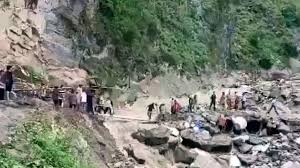Pilgrimage Route Turns Perilous
By: Javid Amin | Jammu | August 14, 2025
On what should have been a day of devotion and community service, the Machail Mata Yatra route in Chositi, Paddar, turned into a scene of devastation. A massive cloudburst on August 14, 2025, triggered sudden flash floods, sweeping away structures, damaging homes, and leaving multiple families in mourning.
The disaster struck during peak pilgrimage activity, when langars (community kitchens) were serving thousands of devotees. The sudden torrent washed away one such langar shed and nearby houses, taking with it lives, livelihoods, and the spirit of festivity that had filled the air just hours earlier.
What is a Cloudburst – and Why Paddar is at Risk
A cloudburst is an extreme rainfall event, often delivering 100 mm or more of rain within an hour over a very small area. When such an event occurs in steep mountain terrain like Paddar, the water accelerates rapidly, becoming a destructive flash flood.
Paddar’s vulnerability stems from:
-
Narrow valleys that funnel water into concentrated torrents.
-
Steep slopes that prevent infiltration and increase runoff.
-
Pilgrimage structures and temporary shelters often built close to streambeds.
The Machail Mata Yatra route, while spiritually significant, passes through several such vulnerable points, making the region highly sensitive to sudden weather events.
The Sequence of Events – From Calm to Chaos
Eyewitnesses report that the day began with overcast skies, but no sign of imminent danger. Shortly after midday, dark cumulonimbus clouds formed over the mountains, followed by a deafening downpour. Within minutes, a wall of water carrying rocks, mud, and debris surged through the Chositi area.
The langar shed, set up to serve free meals to yatris, was among the first to be struck. Volunteers scrambled to save supplies and people, but the speed and force of the floodwaters left little time for evacuation. Nearby homes were partially or fully destroyed, their residents caught in the chaos.
Casualties and the Human Toll
According to initial reports, at least 15 people are feared dead, with several others still missing. Many of the missing are believed to have been inside or near the langar shed at the time of impact.
The tragedy has left families in shock, with survivors recounting harrowing escapes — clinging to trees, clambering onto higher ground, and watching helplessly as possessions and loved ones were swept away.
Rescue Operations – Racing Against Time
Rescue operations were launched within hours, spearheaded by:
-
National Disaster Response Force (NDRF)
-
State Disaster Response Force (SDRF)
-
Army and Police units
-
Local administration and volunteers
A control room has been established in Paddar to coordinate efforts. Helicopters remain on standby for aerial evacuation, though bad weather has hampered operations in certain stretches.
Rescuers face challenging conditions — unstable ground, continuous rainfall, and blocked access roads — but continue to search for the missing while providing medical aid to the injured.
Voices from the Ground – Official Statements
-
Union Minister Jitendra Singh:
“Substantial casualties feared. Rescue teams dispatched. All possible assistance being provided.” -
CM Omar Abdullah:
Expressed deep sorrow and extended condolences to the affected families, pledging state support for relief and rehabilitation. -
LG Manoj Sinha:
Directed all agencies to strengthen rescue and relief operations, calling the incident ‘anguishing’ and emphasizing urgency in finding the missing.
Weather Outlook – More Trouble Ahead?
The Meteorological Centre Srinagar has issued a Nowcast warning for:
-
Moderate to heavy rainfall
-
Thunderstorms
-
Gusty winds
The warning is valid for the next 4–6 hours across multiple districts of Jammu & Kashmir, including Kishtwar. Authorities have urged pilgrims, residents, and travelers to remain indoors, avoid riverbanks, and follow official advisories closely.
Broader Context – Climate and Disaster Preparedness
The Chositi cloudburst is part of a worrying pattern of increasing extreme weather events in the western Himalayas. Climate scientists link this rise to:
-
Warmer air holding more moisture, leading to heavier rainfall bursts.
-
Glacier retreat altering local hydrology.
-
Expansion of roads and settlements in hazard-prone zones.
Experts stress the need for:
-
Pilgrimage safety protocols including weather-based route closures.
-
Relocation of temporary structures away from water channels.
-
Early warning systems linked directly to local authorities and on-ground volunteers.
The Road to Recovery
While rescue teams focus on immediate relief, the aftermath will involve:
-
Rebuilding homes and restoring community kitchens.
-
Compensation for victims’ families.
-
Psychological support for trauma-affected survivors.
-
Reviewing Machail Mata Yatra safety measures to prevent similar tragedies.
For many, the pilgrimage route will now carry the memory of those lost in the flood, a reminder of the fragile balance between faith, nature, and human safety in the mountains.
Bottom-Line
The Chositi cloudburst of August 14, 2025 is a stark example of how swiftly Himalayan weather can turn deadly. Amid the grief, the courage of rescuers and community volunteers stands out — a testament to human resilience in the face of nature’s fury.
As rescue efforts continue and weather threats loom, one thing is clear: safeguarding lives in these regions will require not just emergency response, but proactive disaster planning, environmental sensitivity, and a commitment to respecting the raw power of the mountains.




